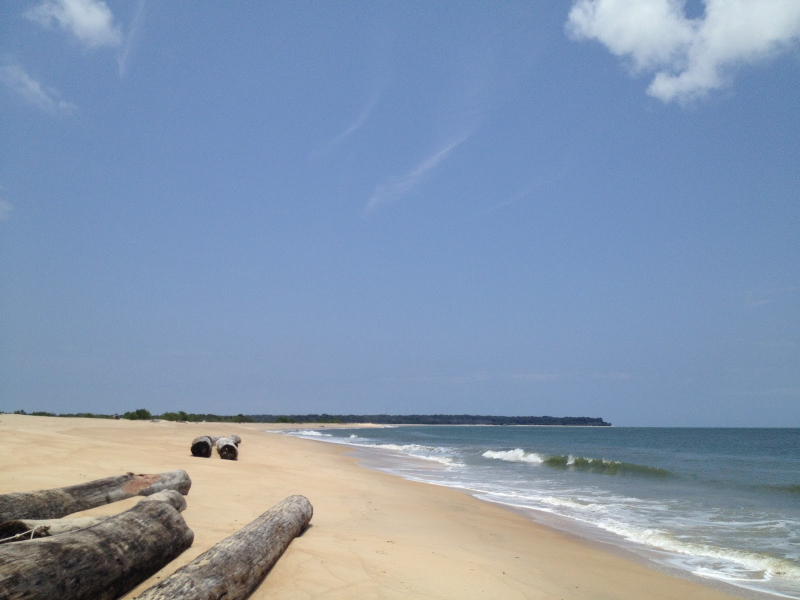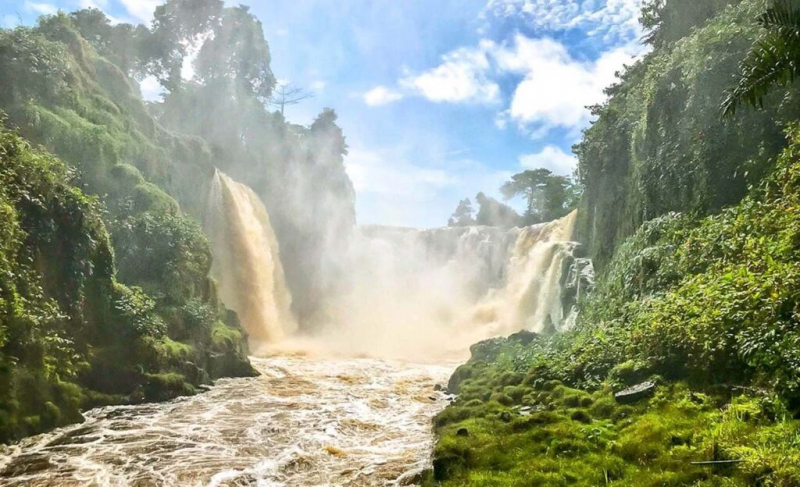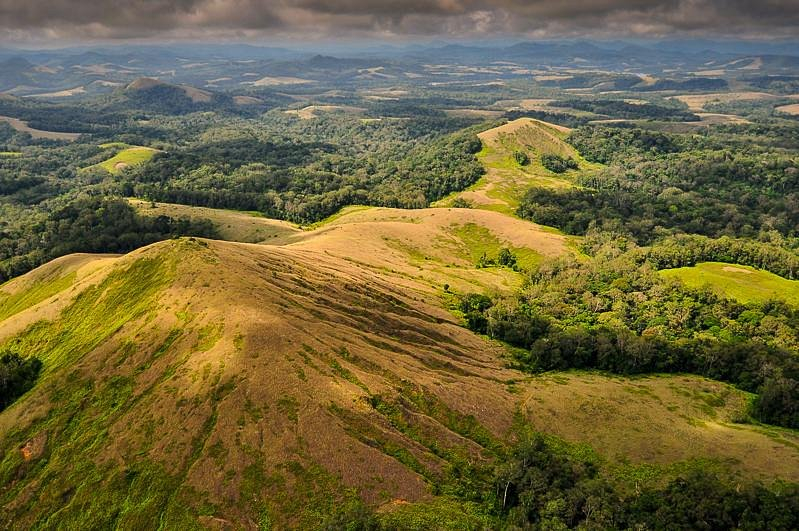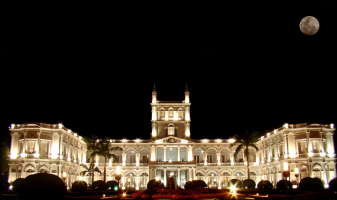Top 11 Best Places to Visit in Gabon
Someone has called Gabon the last Eden on Earth. Once you have visited, you are likely to agree. Leaving the capital, you will find a vast and unexplored ... read more...paradise of white sand beaches, jungles, raging rivers, and pristine landscapes. In 2003, ten percent of the country was set aside as protected land, and 13 national parks were established to preserve this last Eden. Here are the must-go places when you visit this country.
-
Libreville is the largest city and the capital of Gabon, located on the Central African coast. Libreville is a French word that means free city. It is also a port on the Komo River near the Gulf of Guinea, where timber and petroleum are the major commodities shipped around the world.
Once a French colony, Libreville has the bold architectural style of the mother country. You can come across many beautiful ancient buildings like in Europe. The Church of Saint Michel is an interesting landmark in Libreville, famous for its 31 carved wooden columns depicting biblical stories created by a blind Gabon craftsman.
Because of the oil money, you'll find paved streets, clean streets, incredible restaurants, surprisingly good French wine, casinos, and controlled communities.
Libreville is not quite like its neighbors. It has a vibrant African heartbeat complete with fun, crowded markets, close-knit communities, and a stunning coastline.
In addition to the markets, don't forget the National Museum, the Presidential Palace, L'Eglise St-Michel (St Michael's Church), and the Musée des Arts et Traditions du Gabon. When you're ready to relax, let's find a small beach like Ekwata Island and soak up the sunshine.
Location: Capital of Gabon

Libreville. Photo: alkhaleejtours.com 
Libreville. Photo: sostenibilidadhn.wordpress.com -
Loango National Park is the best destination of Gabon, as well as of Africa. It is the place to preserve many tens of kilometers of pristine beaches near freshwater lagoons and equatorial jungle.
What makes the beaches in Loango unique are the animals that walk along the sand – hippos, wild elephants, buffalo, leopards, gorillas, leatherback turtles crawling into the sand to lay their eggs. Sometimes tourists can even see humpback whales spewing water along the coast. At night, crocodiles make tiny trips to the water's edge. From July to September, dolphins and humpback whales will swim into the coastal waters.
With the abundance of wildlife, especially the baboons, and the rich and unique vegetation of the African rainforest, tourism is key to Gabon's poor economy. Most people consider Loango is the number one hunting destination on planet Earth.
Loango National Park is declared a tourist territory that does not violate the ecology. It means you can only go there as part of a tour, which you can buy at any of the tour agencies of Libreville, Igela, and other major tourist centers. It is better to register in advance as the number of visits may be limited due to the seasonal migration of animals and their breeding period.
Location: West of Gabon

Loango National Park. Photo: zambezi.com 
Loango National Park. Photo: flickr.com -
Head to Pongara National Park, one of Equatorial Africa's most untouched coastlines, just 60 minutes from Libreville. More than simply a beachside campsite, the park is also home to Pongara Lodge, which offers stunning views of the Atlantic Ocean.
Pongara National Park is uniquely distinguished by its remarkable diversity of primates, plants, and birds. Heading anywhere along its shimmering estuary, which also cuts through mangrove swamps and flooded forests, you can see snapshots of tree monkeys peering down from tall treetops, forest elephants, and hippos wading in slow-moving lagoons. And just beyond a field along parts of the savannah lies another unspoiled sanctuary for herds of buffalo and small wild elephants, red river pigs, and clouded leopards.
However, it is a marine reserve of the national park, where activity goes up a notch during the breeding season. After the arrival of humpback whales and dolphins in the middle of the year, Pongara's gray beaches become even more pristine and wonderful when thousands of sea turtles nest ashore.
If you visit between November and February, you can check out one of the many educational programs run by Adventures Without Borders - a group that protects turtles and reduce human threats the cause.
Don't miss Chief Rapontchombo's first burial and learn the mysteries of his second burial!
Location: South of the Gabon estuary, near Libreville

Pongara. Photo: thetravelboss.com 
Pongara. Photo: inspirock.com -
The Fernan Vaz Lagoon takes its name from the Portuguese sailor Fernão Vaz, who discovered it in the late 15th century. The church was built in 1889, the same year as the Eiffel Tower, and appears to have some relationship. The church stands tall and elegant, the metal turning a deep red, rusting over the years.
Today, the lagoon is also home to the commendable Fernan-Vaz Gorilla Project. They have been taking care of orphaned gorillas since 2001. Located on Île Evengué-Ezango, the project operates a sanctuary and regeneration center. The four gorillas in the sanctuary, a forest enclosing forest on the island, act as conservation ambassadors to help educate domestic and international visitors about the plight of the great apes.
In addition to visiting the mission and the gorilla sanctuary, you can take a guided walk in the forest or along the beach and visit some villages. Most visitors arrive by boat on a day tour or trek the approximately 50 kilometers of deserted roads and sandy trails that link the mission to Omboué.
Location: the coast of Gabon

Fernan Vaz Lagoon. Photo: bradtguides.com 
Fernan Vaz Lagoon. Photo: bradtguides.com -
Ivindo National Park comprises 3,000 square kilometers and was established in 2002 by President Bongo and is currently managed by WCS and ANPN. As of 2021, it has been listed as a world heritage site.
The park is famous for the spectacular Kongou and Mingouli Falls of the Ivindo River. Kongou Falls is more than 3 km wide and 56 meters high, making it one of the most spectacular places in the country.
The park also includes the Ipassa Makokou Biosphere Reserve and Langoué Baï, which is a cleared forest. Baï is about one kilometer by 300 meters and has a small camp used by the WCS to monitor wildlife in the park.
The mineral-rich soil attracts several animals, especially forest elephants, to feed on the saline soil. Frequent visits by elephants help Baï's survival as they constantly dig up the ground and make it impossible for new trees to grow. Buffaloes also roam the mining area, often accompanied by sitatungas, red river pigs, mangabeys, several species of birds, and even gorillas.
At 300,000 hectares, the park has both Atlantic coastal forest and semi-deciduous forest. It's a wildlife haven and has healthy populations of gorillas and chimpanzees. They also found mandrills, monkeys, leopards, African golden cats, three species of pangolins, buffalo, red river pigs, hippos, bongos, sitatungas, and large herds of forest elephants. The park is also home to tons of bird species (more than 430), and it's not uncommon to see African gray parrots.
Location: East of central Gabon in the provinces of Ogooué-Ivindo and Ogooué-Lolo

Ivindo National Park . Photo: gabontravelandtours.com 
Ivindo National Park . Photo: vi.wikipedia.org -
Dubbed the 'Queen of the African Desert,' Makokou and Kongou Falls are places that never disappoint any visitor when visiting. It is one of the most visited destinations in the entire Dambwa area.
These waterfalls sit almost 300 meters high, making them a wonderful sight to behold even in winter. Those visiting Makokou and Kongou Falls should also try authentic Gabon dishes, such as 'Bogus' and 'Au Virgens' made with locally produced ingredients.
Travel to Makokou and Kongou Falls starts from the town of Mambasa, located at the junction of Makokou and Kongou waterfalls. This area is known for its unique flora, fauna, and geology. These are the things that contribute to making Makokou and Kongou Falls considered one of the best natural destinations in Africa. The falls are also known for gushing water that can be up to 600 gallons per minute! The area is a popular destination for both tourists and locals. Beautiful scenery, peaceful environment, idyllic fishing villages, and abundant wildlife are some of the factors that have contributed to the popularity of this area.
There are also wild animals here. Some tourists to the area include Royal Botswana Anglers and Kenya Safari Company. It is famous not only for its thrilling waterfalls but for the rich flora and fauna that inhabit the area. It is therefore often referred to as the 'Rio Indies' of Africa.
Location: Ivindo National Park, Eastern Gabon

Makokou & Kongou Falls. Photo: africa-wildtours.com 
Makokou & Kongou Falls. Photo: wikimapia.org -
Franceville is one of the four largest cities in Gabon, located on the Mpassa River and at the end of the Trans-Gabon Railway and the N3 road. It arose from a village called Masuku when Pierre Savorgnan de Brazza chose it to resettle former slaves. The city was then called Franceville.
The town has a Church of St Hilaire (built-in 1899), a large statue of President Omar Bongo, a primate medical research institute, and a golf course. Its airport is 20 km to the west, in Mvengué.
There is a market where you can buy many items, including clothing, fruits and vegetables, electronics, and meat. The market also sells bush meat, including African rock pythons, monkeys, and local species of animals.
Franceville's infrastructure is generally of better quality than the rest of the country, largely probably due to the city's importance. There are a few hotels, the most famous of which is the Hôtel Poubara, which overlooks the President's vacation home.
Franceville also has many waterfalls. One of the best known is the Poubara Falls, located alongside a hydroelectric power station that supplies uninterrupted electricity to the area. President Omar Bongo was interred in Franceville on June 18, 2009.
Location: Mpassa River, Gabon

Franceville. Photo: pinterest.com 
Franceville. Photo: flickr.com -
Port-Gentil in the Sea of Ogooué, is the economic capital of Gabon, built on the island of Mandji as a peninsula at the edge of the Atlantic Ocean. The Oil City and industrial center of the country welcomes you to its white sand beaches like kaolin. It is 144 kilometers southeast of the capital Libreville, now accessible by plane, boat, and car, thanks to the majestic Omboué Bridge, one of the longest in the subregion.
Port-Gentil's economic activity represents three-quarters of the country's wealth thanks to its timber industry and especially oil production. On the high seas, Sogara's oil rigs make it the only refinery in the country. The main naval base installation of the Gabonese national navy is also there.
Port-Gentil is also a resort with the most beautiful sea views in the subregion and several attractions. Located not far from Carrefour Léon Mba, the Port Gentil fair is an almost abandoned place but is frequented by many young people. Club Sogara is One of the oldest beach clubs for those who love fine sand and golden sunshine. You can go scuba diving, jet-skiing, windsurfing, or water skiing. Alternatively, you can go camping in the heart of a wildlife reserve, visit Fernanvaz or Nkomi Lagoon, Koumouloundou Plain, or PETIT LOANGO National Park.
Location: Mandji island, Gabon

Port-Gentil. Photo: gabon4you.com 
Port-Gentil. Photo: tripadvisor.com.vn -
Named after the local king, King Denis Rapotchombo, Point Denis is a favorite destination for locals and ex-pats just looking to escape city life.
Located on a peninsula just across the mouth of the Komo River, it offers visitors the best beaches in a beautiful setting. Its waterfront is surrounded by huge mansions of locals and wealthy Europeans.
On the western side of the island, wildlife and local populations can be found, especially along the banks of the Rigolie River and mangroves.
Point Denis is also home to many nature reserves, such as Pongara and Nyonie Reserves. The forest reminds us of the equatorial forest, home to wildebeest, monkeys, birds, snakes, and other reptiles.
Point Denis is ideal for swimming, with clear blue waters. You can snorkel or paddleboard. You'll also be pleased to find a nightclub there, called the Rigolie Nightclub, located in the village behind Assala Lodge. It has plenty of seating, a central dance floor, a bar, and a DJ table. Other options include watching Leatherback Turtles lay eggs, a savannah excursion to see elephants, monkeys, or buffalo. From July to September is the ideal time to go whale watching. Hundreds of whales come to mate off the coast of Gabon.
If you are looking for solitude and long introspective walks with beautiful scenery, Point Denis is for you.
Location: Pongara National Park, Gabon

Point Denis. Photo: thetravelingi.com 
Point Denis. Photo: travelogabon.com -
Réserve de la Lopé is a national park in central Gabon. Although the terrain is mostly monsoon forest, to the north of the park, there are the last remnants of grass savannas created in Central Africa during the last Ice Age, 15,000 years ago. Smack-dab on the equator is the Réserve de la Lopé, complete with savannas, rolling hills, and rainforest, where you can see buffalo, elephants, gorillas, and mandrills.
It was the first reserve in Gabon when the Lopé-Okanda Wildlife Sanctuary was established in 1946. In 2007, the Lopé-Okanda landscape was added to the UNESCO World Heritage List.
The biggest attraction of the Sanctuary de la Lope is the spinning shafts that you will see. You will love it for sure. However, this is not a place for everyone unless they have been to Africa before.
You'll find a research station run by the Zoological Society of London there. You could be at the station, less than five meters from the rainforest. For wildlife and adventure lovers, it is always a pleasure to enjoy the beauty of nature and experience the exciting environment. Make sure to go with your guide and always follow the rules.
Location: central Gabon

Réserve de la Lopé. Photo: tripadvisor.com 
Réserve de la Lopé. Photo: discover-afrika.com -
Lastoursville or Mandji is a city in the east, the central part of Gabon, located on the Ogooué River. It was founded as a slave depot called Mandji, renamed Maadiville in 1883, and finally took its current name François Rigail de Lastours in 1886. It developed around the production of palm oil. It is an administrative center, which soon became a major missionary center.
The town is also known for its caves. Occupying an area of 90 square kilometers, there are more than 40 identified caves located in the dense primeval rainforest near the town. Traces of human activity date back 7,000 years when caves were used in rituals.
The caves were added to the UNESCO World Heritage Tentative List on 20 October 2005 in the Mixed (Cultural + Natural) category.
Location: East-central Gabon

Lastoursville. Photo: flickr.com 
Lastoursville. Photo: flickr.com
































